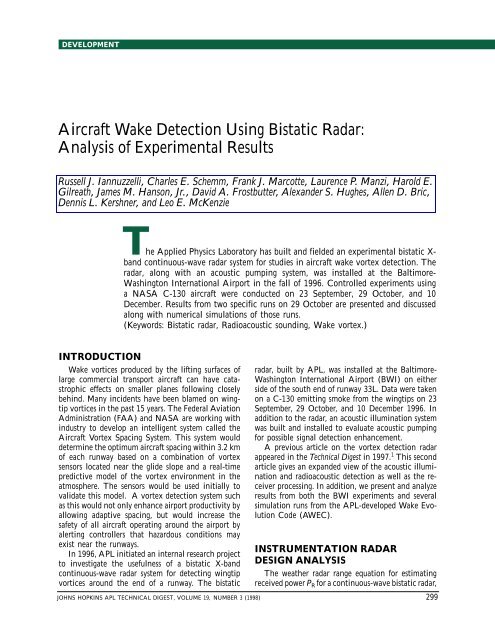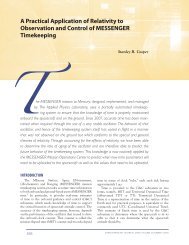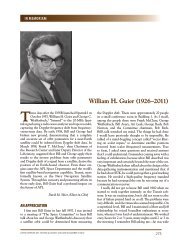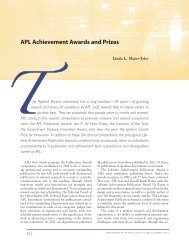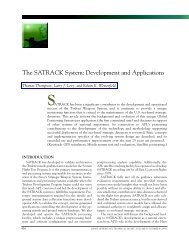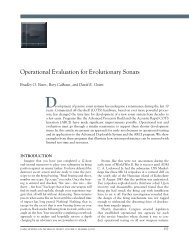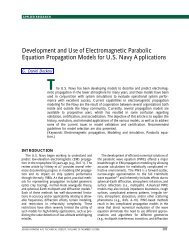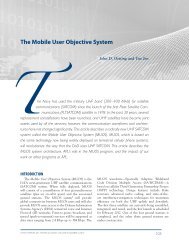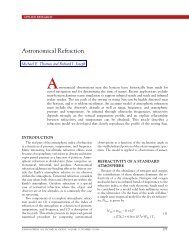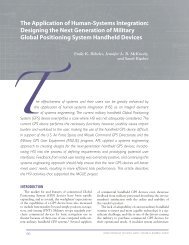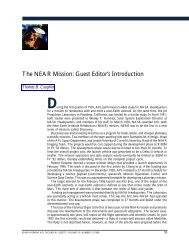Aircraft Wake Detection Using Bistatic Radar: Analysis of ...
Aircraft Wake Detection Using Bistatic Radar: Analysis of ...
Aircraft Wake Detection Using Bistatic Radar: Analysis of ...
Create successful ePaper yourself
Turn your PDF publications into a flip-book with our unique Google optimized e-Paper software.
DEVELOPMENT<br />
<strong>Aircraft</strong> <strong>Wake</strong> <strong>Detection</strong> <strong>Using</strong> <strong>Bistatic</strong> <strong>Radar</strong>:<br />
<strong>Analysis</strong> <strong>of</strong> Experimental Results<br />
AIRCRAFT WAKE DETECTION<br />
Russell J. Iannuzzelli, Charles E. Schemm, Frank J. Marcotte, Laurence P. Manzi, Harold E.<br />
Gilreath, James M. Hanson, Jr., David A. Frostbutter, Alexander S. Hughes, Allen D. Bric,<br />
Dennis L. Kershner, and Leo E. McKenzie<br />
The Applied Physics Laboratory has built and fielded an experimental bistatic Xband<br />
continuous-wave radar system for studies in aircraft wake vortex detection. The<br />
radar, along with an acoustic pumping system, was installed at the Baltimore-<br />
Washington International Airport in the fall <strong>of</strong> 1996. Controlled experiments using<br />
a NASA C-130 aircraft were conducted on 23 September, 29 October, and 10<br />
December. Results from two specific runs on 29 October are presented and discussed<br />
along with numerical simulations <strong>of</strong> those runs.<br />
(Keywords: <strong>Bistatic</strong> radar, Radioacoustic sounding, <strong>Wake</strong> vortex.)<br />
INTRODUCTION<br />
<strong>Wake</strong> vortices produced by the lifting surfaces <strong>of</strong><br />
large commercial transport aircraft can have catastrophic<br />
effects on smaller planes following closely<br />
behind. Many incidents have been blamed on wingtip<br />
vortices in the past 15 years. The Federal Aviation<br />
Administration (FAA) and NASA are working with<br />
industry to develop an intelligent system called the<br />
<strong>Aircraft</strong> Vortex Spacing System. This system would<br />
determine the optimum aircraft spacing within 3.2 km<br />
<strong>of</strong> each runway based on a combination <strong>of</strong> vortex<br />
sensors located near the glide slope and a real-time<br />
predictive model <strong>of</strong> the vortex environment in the<br />
atmosphere. The sensors would be used initially to<br />
validate this model. A vortex detection system such<br />
as this would not only enhance airport productivity by<br />
allowing adaptive spacing, but would increase the<br />
safety <strong>of</strong> all aircraft operating around the airport by<br />
alerting controllers that hazardous conditions may<br />
exist near the runways.<br />
In 1996, APL initiated an internal research project<br />
to investigate the usefulness <strong>of</strong> a bistatic X-band<br />
continuous-wave radar system for detecting wingtip<br />
vortices around the end <strong>of</strong> a runway. The bistatic<br />
radar, built by APL, was installed at the Baltimore-<br />
Washington International Airport (BWI) on either<br />
side <strong>of</strong> the south end <strong>of</strong> runway 33L. Data were taken<br />
on a C-130 emitting smoke from the wingtips on 23<br />
September, 29 October, and 10 December 1996. In<br />
addition to the radar, an acoustic illumination system<br />
was built and installed to evaluate acoustic pumping<br />
for possible signal detection enhancement.<br />
A previous article on the vortex detection radar<br />
appeared in the Technical Digest in 1997. 1 This second<br />
article gives an expanded view <strong>of</strong> the acoustic illumination<br />
and radioacoustic detection as well as the receiver<br />
processing. In addition, we present and analyze<br />
results from both the BWI experiments and several<br />
simulation runs from the APL-developed <strong>Wake</strong> Evolution<br />
Code (AWEC).<br />
INSTRUMENTATION RADAR<br />
DESIGN ANALYSIS<br />
The weather radar range equation for estimating<br />
received power PR for a continuous-wave bistatic radar,<br />
JOHNS HOPKINS APL TECHNICAL DIGEST, VOLUME 19, NUMBER 3 (1998) 299
R. J. IANNUZZELLI ET AL.<br />
in which the transmitter and receiver are spatially<br />
separated, can be shown to be<br />
P<br />
R<br />
2<br />
PGG T T R<br />
= v(<br />
VC ∩VV),<br />
3 2 2<br />
( 4)<br />
R R<br />
T R<br />
(1)<br />
where<br />
PT = transmitter power,<br />
GT and GR = transmitter and receiver antenna gains,<br />
respectively,<br />
= wavelength,<br />
RT and RR = ranges from the transmitter and receiver<br />
to the intersection <strong>of</strong> the two antenna beams,<br />
respectively,<br />
v =reflectivity <strong>of</strong> volume clutter (expressed in m2 /<br />
m3 ),<br />
VC = the common volume, which is contained within<br />
the intersection <strong>of</strong> the transmitter’s and<br />
receiver’s conical beams, and<br />
VV = vortex volume.<br />
For a monostatic radar, the ranges are identical.<br />
From Ref. 2, clear air turbulence reflectivity v can<br />
be expressed as<br />
4<br />
= 2k [ 2k sin( / 2)]<br />
, (2)<br />
v S<br />
where k = 2/ is the radar wavenumber, and S is the<br />
scattering angle, i.e., the angle at which the radar<br />
energy is bent at the common volume from the transmitter<br />
toward the receiver (180° for the monostatic<br />
case). The spectral representation <strong>of</strong> the turbulence is<br />
given by<br />
2 −11/<br />
3<br />
n<br />
( ) = 0. 033C ,<br />
(3)<br />
where is the spatial wavenumber, and 2<br />
C is a struc-<br />
n<br />
ture parameter that measures the intensity <strong>of</strong> turbulent<br />
fluctuations. For the special case <strong>of</strong> homogeneous isotropic<br />
turbulence, 2<br />
C can be expressed in terms <strong>of</strong> the<br />
n<br />
more general structure Dn(r) using<br />
where<br />
2 2/ 3<br />
Cn = r Dn() r<br />
− , (4)<br />
[ ] 2<br />
Dn() r ≡ n( x + r) − n() x<br />
(5)<br />
is the structure function, and r is a spatial increment. The<br />
variable n in Eq. 5 is the refractive index <strong>of</strong> air, which<br />
is related to meteorological variables (temperature,<br />
pressure, humidity). The overbar indicates an ensemble<br />
average. Values <strong>of</strong> 2 16 2/3<br />
C can range from 10 m n<br />
for weak turbulence to 10 12 m 2/3 for very strong<br />
turbulence. 3,4<br />
Vortex detection by radar poses several challenges<br />
to the radar designer. Most <strong>of</strong> the problems arise because<br />
the vortex provides little radar return. Since<br />
most <strong>of</strong> the refraction will be away from the radar<br />
transmitter (Ref. 1), a bistatic arrangement is favored.<br />
The biggest problem with the bistatic continuouswave<br />
radar is the performance degradation due to<br />
phase noise from the spillover signal. Unlike pulse<br />
radars, a continuous-wave radar is both transmitting<br />
and receiving all the time. Time gating, which isolates<br />
a pulse radar receiver from the transmitter, does not<br />
apply with a continuous-wave radar, so other means <strong>of</strong><br />
isolating the high spillover signal from the transmitter<br />
into the receiver must be used. We applied several<br />
techniques to reduce spillover at BWI, including construction<br />
<strong>of</strong> fences around the transmitter and receiver<br />
shelter and separation and pointing <strong>of</strong> the receiver/<br />
transmitter so that sidelobe patterns could help null<br />
out as much <strong>of</strong> the direct spillover as possible. In<br />
addition, we experimented with an active nuller 1 and<br />
adaptive processing, which will be described later in<br />
this article. Figure 1 depicts a hypothetical received<br />
signal spectrum, with a finite-passband noiselike vortex<br />
signal component, a receiver noise component,<br />
and a spillover component with phase noise.<br />
RADIOACOUSTIC DETECTION<br />
OF AIRCRAFT WAKES:<br />
ACOUSTIC PUMPING<br />
In 1961, the Midwest Research Institute developed<br />
a radioacoustic detection system, later known as RASS<br />
(radioacoustic sounding system), as a means for<br />
measuring the temperature pr<strong>of</strong>ile <strong>of</strong> the lower<br />
300 JOHNS HOPKINS APL TECHNICAL DIGEST, VOLUME 19, NUMBER 3 (1998)<br />
Power received (dBm/Hz)<br />
–60<br />
–80<br />
–100<br />
–120<br />
–140<br />
–160<br />
–180<br />
Vortex signal<br />
Receiver noise<br />
Spillover<br />
Phase noise<br />
–200 –150 –100 –50 0 50 100 150<br />
Doppler frequency (Hz)<br />
Figure 1. Illustration <strong>of</strong> received vortex signal spectrum showing the<br />
major components. Turbulent fluctuations, C n 2 , were 10 12 , 10 14 ,<br />
and 10 16 m 2/3 for strong, moderate, and weak turbulences,<br />
respectively. <strong>Radar</strong> specifications were transmitter power = 400 W,<br />
beamwidth = 1.6°, transmitter/receiver separation = 1620 m, and<br />
vortex height = 61 m.
atmosphere. 5 The method was later refined and extended<br />
elsewhere, notably at Stanford University, 6,7 in<br />
the former Soviet Union, 8–10 and most recently in<br />
Norway. 3 In such a system, acoustic waves are transmitted<br />
into the atmosphere to produce traveling perturbations<br />
in the index <strong>of</strong> refraction that can be sensed<br />
by a bistatic radar. The design depends on establishing<br />
the Bragg scattering condition, in which the RF energy<br />
that is scattered from successive acoustic wavefronts<br />
adds coherently at the receiver. For a simple collinear<br />
configuration, with the transmitter and receiver equidistant<br />
from the acoustic source (cf. Fig. 2), this condition<br />
occurs when<br />
k = 2k sin( / 2),<br />
(6)<br />
a S<br />
where k a is the acoustic wavenumber.<br />
By virtue <strong>of</strong> the movement <strong>of</strong> the scattering wavefronts,<br />
the frequency <strong>of</strong> the received RF signal is shifted<br />
by an amount equal to the Doppler frequency f d,<br />
which, for a quiescent atmosphere, equals the frequency<br />
<strong>of</strong> the acoustic source f a:<br />
f d = fa =− kavs ,<br />
(7)<br />
where v s is the sound speed. A change in the speed <strong>of</strong><br />
the wavefronts, which can be due to the advection <strong>of</strong><br />
the waves by air currents or by a variation in sound<br />
speed, changes the Doppler frequency, and tracking<br />
this change is the basis for measuring wind speed or<br />
temperature.<br />
An idealized version <strong>of</strong> a radioacoustic system has<br />
been analyzed 2 for the case <strong>of</strong> Fraunh<strong>of</strong>er scattering<br />
from advecting perturbations in the refractive index.<br />
Applying this analysis to the configuration shown in<br />
Fig. 2, and arranging the results in the form <strong>of</strong> the<br />
bistatic radar equation, we obtain<br />
h<br />
x<br />
z<br />
Common<br />
volume<br />
s<br />
s /2 <br />
Transmitter Acoustic source<br />
Receiver<br />
Figure 2. Radioacoustic detection <strong>of</strong> aircraft vortices ( s = scattering<br />
angle, = antenna beamwidth, and h = height.)<br />
( ) ( )<br />
⎧ 2 2 3 4<br />
P= r Pg T /<br />
⎡<br />
4<br />
R<br />
⎤⎫<br />
⎨<br />
⎬,<br />
⎩ ⎣⎢ ⎦⎥<br />
⎭<br />
AIRCRAFT WAKE DETECTION<br />
JOHNS HOPKINS APL TECHNICAL DIGEST, VOLUME 19, NUMBER 3 (1998) 301<br />
(8)<br />
where P r = echo power, g = antenna gain, and R =<br />
range.<br />
The variable is an effective cross section (radar<br />
cross section <strong>of</strong> the entire volume), which is shown<br />
to be<br />
⎧ 4<br />
<br />
⎡ 2 2<br />
<br />
⎤⎫<br />
C⎨ Pg a a k / 4 h ⎬,<br />
(9)<br />
⎩ ⎣⎢ ⎦⎥<br />
⎭<br />
= ( ) ( )<br />
where P a is the power <strong>of</strong> the acoustic source, g a is the<br />
acoustic antenna gain, h is the distance from the acoustic<br />
source to the center <strong>of</strong> the common volume, the<br />
constant C is given by<br />
2 3 − 15 2<br />
C = 2(K )/( v ) ≈ 3. 69 × 10 m /W, (10)<br />
s<br />
and K is the Gladstone-Dale constant (see the boxed<br />
insert).<br />
For the radioacoustic configuration used in the BWI<br />
experiments, the acoustic line in the Doppler spectrum<br />
was readily detected under ambient conditions at the<br />
proper frequency (Fig. 3). However, the echo power<br />
predicted using Eq. 10 for the effective cross section<br />
was found to greatly exceed the level actually measured.<br />
The reason for the large difference is not clear,<br />
but it might stem from the coarseness <strong>of</strong> the initial<br />
theoretical approximations. The assumption <strong>of</strong> Fraunh<strong>of</strong>er<br />
conditions implies that the phase fronts <strong>of</strong> the<br />
refracted RF waves are planar throughout the common<br />
volume, and requires that the receiver be in the far<br />
field <strong>of</strong> this volume. Neither constraint is satisfied<br />
in the BWI configuration, but the role these factors<br />
play in the discrepancy remains unresolved. The limitations<br />
<strong>of</strong> time and scope have prevented further<br />
investigation.<br />
As noted earlier, changes in the speed <strong>of</strong> the wavefronts,<br />
and thereby changes in the Doppler frequency,<br />
can be caused either by alterations in the local speed<br />
<strong>of</strong> sound or by the advection <strong>of</strong> the waves by air currents<br />
within the common volume. Both <strong>of</strong> these effects<br />
occur when a vortex wake descends into the field <strong>of</strong><br />
view <strong>of</strong> the radar. In general, the change in Doppler<br />
frequency equals<br />
f = − k ( v<br />
+w<br />
(11)<br />
d a s ),<br />
where the perturbation in sound speed v s depends on<br />
changes in temperature and composition, and w is the
R. J. IANNUZZELLI ET AL.<br />
THE CONNECTION BETWEEN SOUND PRESSURE LEVEL AND RADAR CROSS SECTION<br />
Applying the assumptions and analysis in Ref. 2, the<br />
variable can be related to the change in index <strong>of</strong> refraction<br />
induced by the sound waves by<br />
4 2 2 2<br />
=( 14 / ) k VC( nh) cos <br />
.<br />
In this equation, V C ~ (x) 3 / s is the common volume<br />
defined by the RF transmitter and receiver beam patterns<br />
in Fig. 2, and k is the RF wavenumber. The term nh is the<br />
amplitude <strong>of</strong> the index <strong>of</strong> refraction variations within this<br />
volume, which are represented as a train <strong>of</strong> plane waves,<br />
Acoustic<br />
line<br />
n = nhcos[ka(z vst)] ,<br />
where v s is the sound speed and k a is the acoustic wavenumber.<br />
The change in index <strong>of</strong> refraction can be related to the<br />
acoustic pressure by<br />
n =K()=K(p)/v s ,<br />
“Zero Doppler”<br />
spillover<br />
T = 63.69 s<br />
Figure 3. Spectrogram <strong>of</strong> run 9 on 29 October 1996 (10-kHz bandwidth).<br />
where K (by definition) is the Gladstone-Dale constant and<br />
is the air density. The acoustic pressure (p), in turn, is<br />
related to the intensity <strong>of</strong> the sound waves in the common<br />
volume by<br />
p =2(v s)I,<br />
where the intensity is given by<br />
I =[Paga/(4h 2 )] exp(2h).<br />
Here, P a is the power <strong>of</strong> the acoustic source, g a is the<br />
acoustic antenna gain, and h is the distance from the acoustic<br />
source to the center <strong>of</strong> the common volume. The variable<br />
is the absorption coefficient, which depends on the acoustic<br />
frequency, the transport properties <strong>of</strong> air, and the relative<br />
humidity. For the range <strong>of</strong> altitudes and frequencies <strong>of</strong> interest<br />
in the present work, is negligibly small, even at<br />
100% relative humidity. The bracketed expression given in<br />
Eq. 9 in the text results from using the above relationships,<br />
with set equal to zero.<br />
component <strong>of</strong> the vortex velocity<br />
field parallel to the acoustic axis.<br />
Because these variables are distributed<br />
nonuniformly, we might<br />
expect to see the Doppler spectrum<br />
broaden from a line to a<br />
continuous spectrum <strong>of</strong> width<br />
(f d) max as the vortex wake moves<br />
into the common volume. This<br />
was not the case, however; observations<br />
showed a large signal<br />
dropout correlating with the arrival<br />
<strong>of</strong> the descending wake (see the<br />
Results section for a discussion).<br />
PROCESSING<br />
Receiver Processing<br />
Figure 4 is a block diagram <strong>of</strong><br />
the receiver processing. Both<br />
channels—the main vortex channel<br />
that is collecting information<br />
from the common volume (as well<br />
as spillover from sidelobes) and the<br />
reference channel—are mixed to<br />
approximately 25 kHz. From there,<br />
both channels are sent through a<br />
bandpass anti-alias filter. The data<br />
302 JOHNS HOPKINS APL TECHNICAL DIGEST, VOLUME 19, NUMBER 3 (1998)
Vortex<br />
channel<br />
Reference<br />
channel<br />
Center @ 25 kHz<br />
Anti-alias<br />
X bandpass<br />
filter<br />
X<br />
Anti-alias<br />
bandpass<br />
filter<br />
Center @ 25 kHz<br />
Oscillator Tunable<br />
A/D<br />
32K<br />
samples/s<br />
Metrum<br />
data<br />
recorder Clock<br />
A/D<br />
32K<br />
samples/s<br />
Figure 4. Receiver processing block diagram.<br />
Digital<br />
receiver<br />
Digital<br />
data<br />
recorder<br />
Digital<br />
receiver<br />
are then recorded on a Metrum RSR-512 rotary storage<br />
data recorder at an 80-kHz sampling rate and are<br />
sent for real-time data processing on a VME system at<br />
a sampling rate <strong>of</strong> 32 kHz. This latter rate, along with<br />
a downconversion/filtering scheme, will preserve up to<br />
8 kHz <strong>of</strong> complex digital bandwidth, depending on<br />
which digital filter is used. All the digital filters are<br />
flat for approximately 75 to 85% <strong>of</strong> the passband, with<br />
out-<strong>of</strong>-band rejection greater than 90 dB. The four<br />
different digital filters, at ±4096, 2048, 1024, 512 Hz,<br />
use between 128 and 512 taps. From there, a time/<br />
frequency spectrogram is performed on the data, with<br />
a variety <strong>of</strong> time/frequency resolutions possible. The<br />
spectrogram, which is displayed in real time on a PC,<br />
is described next.<br />
Spectrogram Processing and Display<br />
Briefly, a spectrogram is a specific type <strong>of</strong> time/<br />
frequency distribution based on the periodogram, with<br />
extensions built in for time resolution. Many types <strong>of</strong><br />
time/frequency distributions have received much attention;<br />
however, for real-time display, none can compare<br />
to the fast Fourier transform (FFT)-based distribution<br />
in terms <strong>of</strong> computational speed.<br />
Figure 5 is a block diagram <strong>of</strong> overlapping FFT<br />
processing known as the spectrogram. After the digital<br />
receivers, the complex data are buffered. This allows<br />
the FFT to be overlapped by any<br />
desired amount. Three parameters<br />
control the spectral processing. (1)<br />
FFTsize is the size <strong>of</strong> the FFTs used<br />
(typically 256, 512, or 1024<br />
points). (2) FFTdsize is the data<br />
size portion <strong>of</strong> the FFTsize. Typically,<br />
this is at most the FFTsize or 1<br />
to 2 powers <strong>of</strong> 2 smaller. This parameter,<br />
along with the sampling<br />
rate and the specific digital filter<br />
used in the digital receiver, will<br />
establish the spectral resolution. If<br />
I/Q<br />
data<br />
Data buffering<br />
several seconds<br />
<strong>of</strong> data<br />
Spectral<br />
and<br />
adaptive<br />
processing<br />
AIRCRAFT WAKE DETECTION<br />
a windowing function is used, it<br />
may also affect the resolution. (3)<br />
FFTndsize is the new data size<br />
portion <strong>of</strong> the FFTdsize for FFT<br />
processing, which will typically be<br />
at most the FFTdsize or perhaps 1<br />
to 4 powers <strong>of</strong> 2 smaller. This parameter<br />
will establish the time resolution<br />
<strong>of</strong> the spectrogram. In addition<br />
to these parameters, the<br />
noise floor parameter can be set to<br />
between 10 and 150 dB, and<br />
variable infinite impulse responsetype<br />
averaging can be performed<br />
on the postmagnitude operation.<br />
Figure 3 is an example <strong>of</strong> the<br />
spectrogram for run 9 on 29 October, with FFTsize =<br />
1024, FFTdsize = 512, and FFTndsize = 128 in a digital<br />
bandwidth <strong>of</strong> ±5000 Hz. With these parameters set,<br />
along with a Hanning windowing scheme that reduces<br />
the spectral resolution, the spectral resolution is approximately<br />
15 Hz. The time resolution is approximately<br />
0.13 s, since this is the amount <strong>of</strong> spectral<br />
integration that occurs between successive FFTs. In<br />
Fig. 3, time progresses downward, where extent <strong>of</strong> the<br />
time scale is a function <strong>of</strong> the number <strong>of</strong> graphics pixels<br />
in the display window. With a 1024 768 display<br />
mode set, this window yields approximately 78 s <strong>of</strong><br />
simultaneously viewable spectrogram data. The interpretation<br />
<strong>of</strong> the data will be discussed in the Results<br />
section.<br />
Adaptive Processing<br />
The spillover from the transmitter to the receiver<br />
is several orders <strong>of</strong> magnitude larger than any atmospherically<br />
based signal reflected down from the common<br />
volume. This makes any detections close to the<br />
zero-Doppler frequency difficult to obtain. To cancel<br />
some <strong>of</strong> the spillover, the reference channel is used to<br />
adaptively cancel anything that is common. Illuminator<br />
phase noise is common to both channels and thus<br />
should cancel, whereas the vortex signal, which is not<br />
contained in the reference channel, should become<br />
FFTdsize<br />
data<br />
points<br />
JOHNS HOPKINS APL TECHNICAL DIGEST, VOLUME 19, NUMBER 3 (1998) 303<br />
FFT<br />
Display<br />
FFTsize<br />
data<br />
points<br />
FFTndsize Possible<br />
zero padding<br />
Windowing<br />
Complex data<br />
Output FFT line<br />
(FFTndsize* sample<br />
period in seconds)<br />
Real data<br />
IIR<br />
filter<br />
Average<br />
time constant<br />
20 log ( )<br />
Lower<br />
limit<br />
Figure 5. Block diagram <strong>of</strong> spectrogram FFT processing (IIR = infinite impulse<br />
response).
R. J. IANNUZZELLI ET AL.<br />
more apparent after adaptive processing.<br />
The formulation for this<br />
adaptive process assumes that the<br />
main vortex channel has two components:<br />
the common volume<br />
component and the direct spillover<br />
component. The reference<br />
channel is first phase-shifted and<br />
scaled to match the zero-Doppler<br />
magnitude and phase <strong>of</strong> the vortex<br />
channel peak, and then subtracted.<br />
The subtraction is performed in<br />
the frequency domain before the<br />
magnitude is taken. This has typically<br />
reduced the power in the<br />
zero-Doppler component in the<br />
main vortex channel by as much as<br />
30 dB. Figure 6 is a block diagram<br />
<strong>of</strong> the adaptive processing, which<br />
Vortex<br />
I/Q<br />
data<br />
Data buffering<br />
several seconds<br />
<strong>of</strong> data<br />
can be contrasted to the spectrogram processing depicted<br />
in Fig. 5. Many runs were looked at with this<br />
process, and for those <strong>of</strong> importance on 29 October,<br />
adaptive processing was not needed since the returns<br />
were quite large.<br />
THE BWI EXPERIMENT<br />
Both the Maryland Aviation Administration and<br />
the FAA where extremely helpful and receptive to the<br />
idea <strong>of</strong> allowing APL to install and operate the bistatic<br />
radar on the south side <strong>of</strong> runway 33L (Fig. 7). As<br />
mentioned previously, because <strong>of</strong> the proximity <strong>of</strong> the<br />
test site to a highway, wire screen fences (Fig. 8) were<br />
installed around both locations. This cut down reflections<br />
from cars as well as the direct path signal from<br />
the transmitter to the receiver.<br />
The traffic interference can be recognized in waterfall<br />
spectra as a double S-shaped curve with an inflection<br />
point at zero Doppler (Fig. 3). This region <strong>of</strong> zero<br />
Doppler occurs when the vehicle is midway between<br />
the transmitter and receiver and the rate <strong>of</strong> change <strong>of</strong><br />
the sum <strong>of</strong> the ray paths from the transmitter and the<br />
receiver to the vehicle is zero. At times prior to this<br />
there is a decreasing positive rate <strong>of</strong> change (positive<br />
Doppler); after the midway point there is an increasing<br />
negative Doppler. The maximum positive and negative<br />
velocity is limited to that <strong>of</strong> a monostatic radar<br />
with a completely radial component. Traffic interference<br />
can be seen in the actual waterfall data <strong>of</strong> Fig.<br />
3 as depicted in Fig. 9.<br />
Initial checkout <strong>of</strong> the system consisted <strong>of</strong> antenna<br />
alignment testing followed by measurement <strong>of</strong> receiver<br />
signal levels in clear air, both with and without acoustic<br />
pumping. Also, with the runway out <strong>of</strong> service, the<br />
acoustic transmitter was moved to several locations<br />
along its centerline, and receiver signal levels were<br />
Windowing<br />
20 log ( )<br />
304 JOHNS HOPKINS APL TECHNICAL DIGEST, VOLUME 19, NUMBER 3 (1998)<br />
FFT<br />
FFTndsize Possible<br />
zero padding<br />
Data buffering<br />
several seconds<br />
<strong>of</strong> data<br />
Reference<br />
I/Q<br />
data<br />
FFTdsize<br />
data<br />
points<br />
FFT<br />
FFTsize<br />
data<br />
points<br />
Complex data<br />
Reference channel<br />
phase-shifted and<br />
subtracted from main<br />
vortex channel<br />
Real data<br />
IIR<br />
filter<br />
Average<br />
time constant<br />
Figure 6. Block diagram <strong>of</strong> adaptive spectrogram FFT processing.<br />
Output FFT line<br />
(FFTndsize* sample<br />
period in seconds)<br />
Lower<br />
limit<br />
monitored. During this phase <strong>of</strong> testing, the acoustic<br />
transmitter consisted <strong>of</strong> a Peavy 44T compression driver<br />
loaded with a 60° horn, which was typically driven<br />
with less than 20 W. A digital synthesizer was used to<br />
generate a sinusoidal input to the amplifier, which<br />
could be varied in frequency.<br />
Tests confirmed that the optimal orientation <strong>of</strong> the<br />
acoustic source was vertical and directly in line between<br />
the transmitter and receiver along the centerline<br />
<strong>of</strong> the runway; i.e., at about 79 m from the south<br />
end <strong>of</strong> the runway. Unfortunately, commercial aircraft<br />
are at a very low altitude as they pass over this point,<br />
perhaps ≈50 m or less. At this altitude, a vortex can<br />
be unstable and dissipate quickly. To allow better control<br />
<strong>of</strong> the test environment, arrangements were made<br />
for a NASA C-130 aircraft from Wallops Island, Virginia,<br />
to overfly the runway on several days. These<br />
flights were funded by NASA as a contribution to the<br />
APL research efforts.<br />
Test <strong>Aircraft</strong><br />
The C-130 aircraft was equipped with smoke<br />
generators (smokers) installed on both wingtips. The<br />
smokers burned corvus or canopus oil at the wingtip,<br />
which caused the smoke to became entrapped in the<br />
vortex core (see Fig. 10). The entrapped smoke allowed<br />
visual tracking <strong>of</strong> the otherwise invisible vortex.<br />
The right-tip smoker was inoperative for the first two<br />
test dates owing to a defective switch in the cockpit;<br />
however, both tip smokers were operational during the<br />
third and final test date.<br />
Pretest instructions required the C-130 crew to fly<br />
the glide slope until reaching the requested altitude,<br />
which was to be held until the aircraft passed 305 m<br />
beyond the runway threshold. To conserve the corvus<br />
oil, the smoke was to be turned on 305 m prior to the
(a)<br />
Runway 33L<br />
MD Rte. 176 Receiver Transmitter<br />
(b)<br />
Receiver<br />
<strong>Radar</strong> fence<br />
Touchdown area<br />
Runway<br />
33L<br />
Acoustic<br />
pumping<br />
device<br />
runway threshold and turned <strong>of</strong>f 305 m beyond the<br />
threshold. A NASA video <strong>of</strong> the C-130 taken during<br />
a previous test at Wallops Island revealed that the tip<br />
vortices would break up if the landing flaps were used.<br />
Therefore, the C-130 was instructed to fly by the APL<br />
test sight in a “clean” configuration (gear and flaps up)<br />
at a speed <strong>of</strong> 1.3 Vso (120–130 kt). (Vso = stall speed<br />
or minimum steady flight speed at which the aircraft<br />
is controllable in the landing configuration.) At this<br />
speed and at maximum fuel weight, the strength <strong>of</strong> the<br />
vortices generated by the C-130 equaled that generated<br />
by a Boeing 727.<br />
<strong>Radar</strong> fence<br />
Transmitter<br />
15–120-m<br />
common<br />
volume<br />
height<br />
600-m<br />
transmitter/receiver<br />
separation<br />
Figure 7. BWI vortex detection test site on runway 33L: (a) aerial photograph and (b)<br />
schematic view.<br />
Figure 8. <strong>Wake</strong> vortex receiver at BWI.<br />
AIRCRAFT WAKE DETECTION<br />
During the test, the C-130 received<br />
instruction via a UHF radio<br />
that was based at the radar receiver<br />
location. APL would transmit altitude<br />
and lateral displacement instructions<br />
to the crew before each<br />
flyby. The co-pilot received instructions<br />
from the APL test site,<br />
while the pilot communicated<br />
with the control tower at BWI.<br />
Data Collection Procedures<br />
A typical run <strong>of</strong> the C-130 involved<br />
at least six people: four at<br />
the receiver container, one at the<br />
transmit container, and one at the<br />
acoustic site. One person (local<br />
controller) was in voice communication<br />
with the C-130 at all times.<br />
The local controller and at least<br />
three other people were at the receiver<br />
container and would specify<br />
a height above the runway and<br />
distance from side to side <strong>of</strong>fset<br />
from the runway to the crew. A<br />
“mark” would be given to the two<br />
or three people manning the receiver<br />
equipment that the C-130<br />
was about 305 m out. Data collection<br />
usually started at this point.<br />
Visual contact was also made by<br />
the person voice-annotating the<br />
Metrum data. The receiver container,<br />
the transmit container,<br />
and the person manning the<br />
acoustic illuminator were all in<br />
radio communication. The person<br />
at the acoustic setup, which was<br />
in-line with the runway, would<br />
give a mark when the C-130 was<br />
over Dorsey Road and then when<br />
JOHNS HOPKINS APL TECHNICAL DIGEST, VOLUME 19, NUMBER 3 (1998) 305
R. J. IANNUZZELLI ET AL.<br />
20<br />
0<br />
Time (s) 40<br />
–20<br />
–40<br />
–1500 –1000 –500 0 500 1000 1500<br />
Doppler frequency (Hz)<br />
Figure 9. Interference shown for a vehicle traveling 40 mph on<br />
Rte. 176.<br />
over the common volume. At this point, most <strong>of</strong> the<br />
voice annotation centered on the vortex smoke trails<br />
as seen by the receiver video camera. When the transmit<br />
container saw smoke in the transmit monitor, radio<br />
contact was made and notes taken at the receiver<br />
container specifying the degree <strong>of</strong> visual collaboration<br />
<strong>of</strong> smoke in the cameras at the receiver and transmit<br />
sites. This procedure worked well in establishing which<br />
<strong>of</strong> the many data runs were worth further investigation.<br />
Observed Vortex Behavior<br />
The behavior <strong>of</strong> the wingtip vortices was videotaped<br />
during the three test periods. Near-surface temperature<br />
and wind data were recorded at the radar<br />
receiver site. Recording devices were not allowed near<br />
or above the runway surface. Operations during the<br />
evening hours provided the most stable atmospheric<br />
conditions for the first test period. Because <strong>of</strong> the time<br />
change to Eastern Standard Time after the first tests<br />
and the heavy airline activity, the second and third<br />
tests were conducted during the morning and afternoon<br />
hours. A general description <strong>of</strong> the wind conditions<br />
and the vortex behavior during each test period<br />
is given in the following paragraphs.<br />
The first test began at 5:20 p.m. on 23 September.<br />
Winds were 5 to 10 kt along the runway centerline.<br />
The C-130 made 20 passes by the APL test site at<br />
altitudes ranging from 15 to about 107 m above ground<br />
level (AGL). As noted earlier, the left wingtip smoker<br />
worked, but the right tip had malfunctioned. The lefttip<br />
vortex lasted more than 2 min after the C-130 flyby.<br />
The vortex remained near the runway centerline at<br />
approximately 12 m AGL. In some cases, the vortex<br />
passed through the boresight camera’s view and would<br />
reappear shortly thereafter, giving the false impression<br />
that the vortex was rising. Instead, it remained near<br />
about 12 m AGL but underwent a wavelike oscillation.<br />
The peak <strong>of</strong> the wave motion reappeared in the boresight<br />
camera’s view.<br />
The first test date provided the best atmospheric<br />
conditions for vortex longevity, but posttest analysis<br />
determined that the radar’s common volume was too<br />
low and the local traffic on Dorsey Road caused too<br />
much interference in the radar data.<br />
The second test started at 9:50 a.m. on 29 October.<br />
Again, the right-tip smoker had malfunctioned. Initially,<br />
winds were approximately 15 to 20 kt across the<br />
runway. In some cases, the C-130 was instructed to fly<br />
at two wingspans about 80 m to the right <strong>of</strong> the runway<br />
centerline in hopes that the vortices would pass<br />
through the radar’s common volume. After six passes,<br />
the winds decreased to light and variable and the<br />
C-130 was instructed to fly over the runway centerline.<br />
Fifteen passes were made by the C-130 until the BWI<br />
tower terminated testing owing to increasing commercial<br />
air traffic. The second half <strong>of</strong> this test provided the<br />
best radar data.<br />
The third and final test date was 10 December. The<br />
malfunction in the right-tip smoker had been corrected,<br />
thereby allowing the observation <strong>of</strong> the interaction<br />
306 JOHNS HOPKINS APL TECHNICAL DIGEST, VOLUME 19, NUMBER 3 (1998)<br />
(a)<br />
(b)<br />
Figure 10. The NASA C-130 research aircraft with generator on<br />
left wing. (a) Trailing vortex seen on approach to BWI. (b) Smokemarked<br />
vortex as seen several seconds after the C-130 passed<br />
by (a).
etween the left and right vortices. The C-130 was<br />
committed to a full day <strong>of</strong> testing, which included a<br />
landing at BWI with the smokers on. Wind conditions<br />
were less than ideal, with estimated crosswinds at<br />
velocities <strong>of</strong> 20 to 25 kt. Lateral positioning <strong>of</strong> the C-<br />
130 was difficult owing to the variation in the wind<br />
velocity and direction. Even under these conditions<br />
the tip vortices would remain intact for over 1 min.<br />
The vortices appeared in the boresight camera’s view<br />
for only a few seconds because <strong>of</strong> the lateral displacement<br />
caused by the crosswinds.<br />
Testing on 10 December began at 10:19 a.m. The<br />
C-130 made 13 passes before the BWI controllers terminated<br />
the test because <strong>of</strong> an increase in commercial<br />
air traffic. At this time, the C-130 landed for refueling<br />
with the smokers on. The tip vortices were destroyed<br />
within two C-130 body lengths, with the landing flaps<br />
fully deflected.<br />
Afternoon testing began at 1:35 p.m. The winds<br />
had not subsided, and lateral positioning remained a<br />
problem. The radar’s common volume was moved in<br />
an attempt to track the vortices as they were displaced<br />
by the crosswinds. At 3:00 p.m., the C-130 made its<br />
40th and final pass <strong>of</strong> the afternoon and returned to<br />
Wallops Island.<br />
RESULTS<br />
No significant Doppler signatures could be correlated<br />
with the times and runs when smoke was seen in<br />
the video cameras on 23 September or 10 December.<br />
On the earlier date, the common volume was at 15 m,<br />
which we later realized was a poor choice because <strong>of</strong><br />
ground effects. On 10 December, the winds made it<br />
difficult to impossible to position the C-130 so that<br />
smoke would drop through the common volume.<br />
Two data runs taken on 29 October are detailed in<br />
the following paragraphs. Both proved to have definitive<br />
Doppler signatures when smoke was observed to<br />
be dropping through the common volume. (A more<br />
detailed presentation <strong>of</strong> the data from all the runs may<br />
be found in Ref. 11.)<br />
The radioacoustic return showed a large signal<br />
dropout correlated with the arrival time <strong>of</strong> the descending<br />
wake (cf. Fig. 11a). The major qualitative<br />
difference between these results and the simplified<br />
picture presented earlier is likely due to a combination<br />
<strong>of</strong> effects associated with three phenomena:<br />
1. <strong>Wake</strong> turbulence. Fluctuations in velocity and temperature<br />
distort the acoustic wavefronts, scattering<br />
the acoustic power and causing a loss <strong>of</strong> coherence in<br />
the wavetrain.<br />
2. Cross-currents. Velocity components perpendicular<br />
to the acoustic axis tilt the Bragg grid, changing its<br />
geometry with respect to the RF beams, and possibly<br />
de-tuning the system.<br />
AIRCRAFT WAKE DETECTION<br />
3. Vertical shear. The presence <strong>of</strong> shear means that<br />
waves are advected by differing amounts in different<br />
parts <strong>of</strong> the wavetrain. When the acoustic axis is<br />
vertical, the fractional change in wavenumber along<br />
a central ray is directly proportional to ∂ w/∂ s, i.e.,<br />
∂( ln k)/ ∂s = −∂w/ ∂s/(<br />
v + w),<br />
JOHNS HOPKINS APL TECHNICAL DIGEST, VOLUME 19, NUMBER 3 (1998) 307<br />
s<br />
(12)<br />
where s is the distance along the ray. The resulting<br />
refraction is strongest in the core region <strong>of</strong> the vortices<br />
and would tend to de-tune the system when the cores<br />
occupy the common volume.<br />
Recall Fig. 3, a spectrogram <strong>of</strong> the data from the<br />
main vortex channel from run 9 (time running from<br />
oldest to newest, top to bottom). Figure 11b is a reduced<br />
bandwidth view <strong>of</strong> the same run. Here the frequency<br />
resolution is approximately 1 Hz as opposed to<br />
15 Hz in Fig. 3. Marks have been added to the time axis<br />
where the smoke was observed in the cameras.<br />
A Doppler event within these marks is evident and is<br />
believed to represent the drop rate <strong>of</strong> the vortex core.<br />
The positive side <strong>of</strong> the Doppler spectrum corresponds<br />
to the “drop side” Doppler, i.e., the path length is being<br />
shortened. Calculations <strong>of</strong> the drop rate from the receiver<br />
video after the fact seem to generally agree with<br />
the drop rate indicated by the spectrogram and with the<br />
results <strong>of</strong> the numerical model calculations (cf. Fig. 15).<br />
Knowing the video camera’s field <strong>of</strong> view and the<br />
approximate distance to the smoke, the video drop rate<br />
was estimated to range from 1.3 to 3.5 m/s. This corresponds<br />
to a Doppler frequency at the specific X-band<br />
frequency used <strong>of</strong> approximately 30 Hz (2 m/s).<br />
Figure 11c is a cut through the spectrogram at the<br />
time when the vortex signature was the strongest.<br />
From this figure, the estimated Doppler <strong>of</strong>fset is approximately<br />
40 Hz. Two other traces are depicted here,<br />
2<br />
attempting to place bounds on Cn using different<br />
measurement methods. The top trace (upper bound)<br />
assumes that the full common volume (about 1000 m3 )<br />
2<br />
is contributing to Cn , and the energy is concentrated<br />
in the narrow frequency band <strong>of</strong> the vortex signal<br />
shown in the figure. The bottom trace (lower bound)<br />
assumes that the received energy is spread over the<br />
frequency band corresponding to the estimated turbulent<br />
velocities contained in the vortex. The figure<br />
2<br />
shows that Cn is several orders <strong>of</strong> magnitude greater<br />
than the upper bound, suggesting that vortices may<br />
2<br />
have Cn values much greater than expected for<br />
strong, clear air turbulence. Another explanation is<br />
that the smoke contained in the vortex is contributing<br />
to overall vortex reflectivity. Compare Fig. 11c with<br />
Fig. 11a, a peak amplitude versus time plot for the<br />
acoustic line. Here, the dropout from the passage <strong>of</strong> the<br />
plane is apparent; however, little else could be counted<br />
on because <strong>of</strong> the wide swings in received power.
R. J. IANNUZZELLI ET AL.<br />
(a)<br />
Acoustic tone spectral power (dB)<br />
–30<br />
–40<br />
–50<br />
–60<br />
–70<br />
–80<br />
–5 0 5 10 15 20 25 30 35 40 45<br />
Elapsed time from C-130 overflight <strong>of</strong> common volume (s)<br />
(b)<br />
“Zero Doppler”<br />
spillover<br />
Vortex<br />
signature<br />
Figure 12 shows the acoustic amplitude, spectrogram,<br />
and single line spectrum for run 15. Again, the<br />
reader will find details on additional runs in Ref. 11.<br />
MODEL PREDICTIONS OF AIRCRAFT<br />
VORTEX WAKES<br />
Model calculations have been carried out for runs<br />
9 and 15 from 29 October. Our objectives were (1) to<br />
determine the extent to which the model could predict<br />
the early evolution (prior to breakup) <strong>of</strong> aircraft vortices<br />
and (2) to help interpret the radar measurements<br />
described in previous sections.<br />
Iannuzzelli-11a<br />
T = 63.69 s<br />
Obviously, some success in model validation is required<br />
if the model is to be used to provide estimates<br />
<strong>of</strong> the location, strength, and internal structure <strong>of</strong> the<br />
atmospheric flow signatures believed to be responsible<br />
for the measured radar returns. Accordingly, our approach<br />
was to first examine the predicted wake vortex<br />
trajectories and then to compare the predicted time <strong>of</strong><br />
arrival <strong>of</strong> the vortex cores at the radar common volume<br />
with the time at which radar signatures were observed.<br />
Since no ground-truth measurements <strong>of</strong> atmospheric<br />
motions were available during the BWI experiment,<br />
these were the only comparisons that could be used to<br />
help establish the model’s credibility. The next step in<br />
308 JOHNS HOPKINS APL TECHNICAL DIGEST, VOLUME 19, NUMBER 3 (1998)<br />
Spectral power (dB)<br />
–20<br />
–60<br />
–80<br />
–100<br />
–100<br />
–50<br />
Spillover<br />
C<br />
–40<br />
2 = 10 –12 n full<br />
volume; power across<br />
measured band<br />
Vortex signal<br />
2.2 m/s<br />
Phase noise<br />
0 50<br />
Doppler frequency (Hz)<br />
C 2 = 10 –12 n vortex volume;<br />
power across<br />
vortex circulation<br />
Figure 11. Run 9 on 29 October 1996: (a) acoustic line power, (b) spectrogram, and (c) single line through spectrogram.<br />
(c)<br />
100<br />
150
Acoustic tone spectral power (dB)<br />
(a)<br />
–30<br />
–40<br />
–50<br />
–60<br />
–70<br />
–80<br />
0 10 20 30 40<br />
Elapsed time from C-130 overflight <strong>of</strong> common volume (s)<br />
(c)<br />
“Zero Doppler”<br />
spillover<br />
the analysis process was to examine features <strong>of</strong> the<br />
predicted vortex wakes (e.g., overall size, internal<br />
structure) to better understand what parts <strong>of</strong> the signature<br />
might be responsible for the measured radar<br />
returns.<br />
Predictions <strong>of</strong> vortex wake evaluation were obtained<br />
using the recently developed APL <strong>Wake</strong> Evaluation<br />
Code (AWEC). AWEC solves steady-state r non-<br />
linear equations for the velocity<br />
V, density ,<br />
turbulence kinetic energy K, and turbulence dissipation<br />
rate , all in a coordinate system that is fixed with<br />
respect to a moving source (in this case, an aircraft)<br />
Vortex<br />
signature<br />
T = 31.85 s<br />
AIRCRAFT WAKE DETECTION<br />
and moves linearly with that source. A second-order<br />
turbulence closure scheme, based largely on the Mellor<br />
and Yamada Level 2.5 model, 12 is used to evaluate the<br />
remaining turbulence correlations.<br />
The principal approximation in AWEC, and the<br />
one that renders the problem tractable, is the so-called<br />
parabolic approximation. The physical assumption<br />
behind this approximation, which is valid for almost<br />
all wake flows, is that changes in the downtrack or x<br />
direction are small compared with changes in the<br />
crosstrack and vertical (y and z) directions. Derivatives<br />
<strong>of</strong> x other than those in advective terms involving the<br />
JOHNS HOPKINS APL TECHNICAL DIGEST, VOLUME 19, NUMBER 3 (1998) 309<br />
Spectral power (dB)<br />
–20<br />
–40<br />
–60<br />
–80<br />
–100<br />
–100<br />
–50<br />
Spillover<br />
C 2 = 10 –12 n full<br />
volume; power<br />
across<br />
measured band<br />
0<br />
Vortex signal<br />
~4.8 m/s<br />
Phase noise<br />
50<br />
100<br />
Doppler frequency (Hz)<br />
Figure 12. Run 15 on 29 October: (a) acoustic line power, (b) spectrogram, and (c) single line through spectrograph.<br />
(b)<br />
C 2 = 10 –12 n vortex<br />
volume; power<br />
across vortex<br />
circulation<br />
150<br />
200
R. J. IANNUZZELLI ET AL.<br />
mean speed <strong>of</strong> advance U are neglected, thereby allowing<br />
the equations to be reformulated and solved as a<br />
marching problem in x. The need to store model<br />
variables at locations along the x axis is eliminated,<br />
thus reducing the problem from three to effectively<br />
two spatial dimensions.<br />
To initialize AWEC model calculations, estimates <strong>of</strong><br />
data are needed at a vertical (y–z) plane close to the<br />
origin. For submarine wake predictions, a separate<br />
program, FWI, 13 is used to generate estimates <strong>of</strong> component<br />
wakes for the many sources that contribute to<br />
the composite wake signature. FWI stores relevant<br />
geometrical variables for different submarines and uses<br />
these values along with operating conditions provided<br />
by the user to compute estimates for variables such as<br />
the size and strength (circulation) <strong>of</strong> vortices shed by<br />
the hull and control surface. For the present aircraft<br />
vortex calculations, it was a fairly straightforward<br />
exercise to add a file containing the wingspan and<br />
other relevant geometrical variables for a C-130 transport<br />
and to use existing s<strong>of</strong>tware to calculate the required<br />
initial plane data. Since the inviscid theory<br />
applied to derive the vortex circulation equations in<br />
FWI was originally developed for the aircraft vortex<br />
problem, there was little risk in applying those same<br />
equations to the problem at hand. And since, unlike<br />
submarine wakes, aircraft wakes are dominated by a<br />
single component, all sources other than wing vortices<br />
could safely be ignored.<br />
Run 9<br />
During run 9, the aircraft was assumed to be in level<br />
flight at an altitude <strong>of</strong> 83.8 m, with an air speed U <strong>of</strong><br />
64.3 m/s. The plane’s weight was taken to be 143,000<br />
lb (64,865 kg), and the lift force L was assumed equal<br />
and opposite to the weight. The wingspan B was about<br />
40.4 m.<br />
The initial vortex circulation 0 was estimated<br />
from the inviscid theory. Assuming elliptical loading,<br />
0<br />
= L<br />
Ub<br />
0<br />
2<br />
= 312 ms / , (13)<br />
where the density <strong>of</strong> air = 1 kg/m 3 , and the vortex<br />
core separation b 0 is given by<br />
<br />
b 0=<br />
B= 31. 7 m. (14)<br />
4<br />
The diameter <strong>of</strong> the vortex core D V is given theoretically<br />
by<br />
D V = 0. 197b0 ,<br />
(15)<br />
which yields an estimate <strong>of</strong> D V = 6.25 m for the<br />
C-130. This value was considerably larger than the<br />
observed core diameter <strong>of</strong> approximately 1 m. The<br />
latter value was determined by the visible boundary <strong>of</strong><br />
the entrained smoke in the photographs. Despite this<br />
discrepancy, the larger theoretical value was used in<br />
the model calculations. Use <strong>of</strong> the smaller value would<br />
have required a minimum grid separation distance<br />
much smaller than the 0.5 m used in the present<br />
calculations, which would have resulted in a nearly<br />
prohibitive increase in the computational burden.<br />
The net downward vertical velocity w 0 induced by<br />
one vortex acting on another is given by<br />
−Γ<br />
w 0=<br />
2b<br />
310 JOHNS HOPKINS APL TECHNICAL DIGEST, VOLUME 19, NUMBER 3 (1998)<br />
0<br />
0<br />
=−157<br />
. m/s . (16)<br />
The atmosphere was assumed to be weakly stratified<br />
with a potential temperature gradient <strong>of</strong> 6.7 10 3<br />
°C/m. Values <strong>of</strong> potential temperature were converted<br />
to density for use by AWEC. Ambient levels <strong>of</strong> turbulence<br />
kinetic energy and turbulence kinetic energy<br />
dissipation rate were chosen to be 0.1 m 2 /s 2 and 2 <br />
10 3 W/kg, respectively.<br />
Figure 13 depicts vector velocities at times late t <strong>of</strong><br />
1.4 (the initial plane), 9.0, 21.0, and 31.0 s. Since the<br />
wing was positioned near the top <strong>of</strong> the fuselage (effective<br />
diameter <strong>of</strong> approximately 5.2 m) on the<br />
C-130, the vortex cores initially were situated 86.4 m<br />
AGL. Figure 14 shows contours <strong>of</strong> the turbulence<br />
kinetic energy for two <strong>of</strong> these times late, 1.4 and 31.0.<br />
The position <strong>of</strong> the radar common volume, which is<br />
centered at 45.7 m AGL, is also shown.<br />
Figure 15a plots the position <strong>of</strong> the vortex cores<br />
(solid curve) as a function <strong>of</strong> t. The heavy dashed line<br />
indicates where the vortex positions would be if the<br />
wake descended at a constant velocity given by the<br />
induced velocity computed from Eq. 16. The actual<br />
vortex descent begins near this speed but then slows.<br />
The fixed upper and lower boundaries <strong>of</strong> the common<br />
volume are indicated by a pair <strong>of</strong> solid horizontal lines.<br />
The outlying lighter dotted lines indicate the first<br />
contour level above ambient <strong>of</strong> the turbulence kinetic<br />
energy distribution.<br />
From Fig. 15a it is estimated that the leading edge<br />
<strong>of</strong> the vortex wake first reached the common volume<br />
approximately 12 s after aircraft passage and that the<br />
vortex cores were within the common volume between<br />
t ≈ 29 and 33 s after aircraft passage. <strong>Radar</strong> results discussed<br />
previously show a distinct signature at t = 31 s,<br />
which appears consistent with the model prediction.<br />
This result, however, could be fortuitous as it depends<br />
on the aircraft altitude at the time <strong>of</strong> passage, and there<br />
is considerable uncertainty in the estimates <strong>of</strong> altitude<br />
obtained from the C-130 pilot.
(a) (b)<br />
120<br />
120<br />
Height (m)<br />
100<br />
80<br />
60<br />
40<br />
20<br />
Run 15<br />
0<br />
–60 –40 –20 0 20 40<br />
Crosstrack (m)<br />
(c) (d)<br />
Height (m)<br />
120<br />
100<br />
80<br />
60<br />
40<br />
20<br />
0<br />
–60 –40 –20 0<br />
Crosstrack (m)<br />
20 40<br />
Figure 13. Run 9 vector velocities at times late <strong>of</strong> (a) 1.4 s, (b) 9.0 s, (c) 21.0 s, and (d) 31.0 s.<br />
Except for the altitude, all model inputs for run 15<br />
were the same as those for run 9. Although the reported<br />
altitude was 64 m, a video tape <strong>of</strong> the aircraft<br />
flying over the common volume shows that the vortex<br />
cores as measured by smoke are in the common volume<br />
at the time <strong>of</strong> passage. Accordingly, an initial vortexcore<br />
height <strong>of</strong> 53.3 m was adopted for the run 15 model<br />
calculation, which resulted in better agreement with<br />
experimental data.<br />
Figure 15b plots the position <strong>of</strong> the vortex cores as<br />
a function <strong>of</strong> time. Again, the actual vortex motion<br />
descent rate is slower than predicted by inviscid theory.<br />
Vortex cores are predicted to be within the common<br />
AIRCRAFT WAKE DETECTION<br />
0<br />
–60 –40 –20 0<br />
Crosstrack (m)<br />
20 40<br />
volume between 6 and 12 s after aircraft passage. This<br />
agrees with the radar observations—an expected result<br />
here since the radar data along with the video were<br />
used to estimate the initial altitude.<br />
DISCUSSION<br />
Radio waves are scattered by turbulent irregularities<br />
in the refractive index <strong>of</strong> air. In the initial stages <strong>of</strong> a<br />
turbulent mixing process, air parcels are rapidly displaced<br />
from each other and their identities are preserved.<br />
It takes a while for diffusion to act and for the<br />
mixed region to become nearly homogeneous again.<br />
The stronger the initial gradients and the turbulence,<br />
JOHNS HOPKINS APL TECHNICAL DIGEST, VOLUME 19, NUMBER 3 (1998) 311<br />
Height (m)<br />
Height (m)<br />
100<br />
80<br />
60<br />
40<br />
20<br />
120<br />
100<br />
80<br />
60<br />
40<br />
20<br />
0<br />
–60 –40 –20 0<br />
Crosstrack (m)<br />
20 40
R. J. IANNUZZELLI ET AL.<br />
(a)<br />
Height (m)<br />
(b)<br />
Height (m)<br />
120<br />
100<br />
80<br />
60<br />
40<br />
20<br />
0<br />
–60 –40 –20 0<br />
Crosstrack (m)<br />
20 40<br />
120<br />
100<br />
80<br />
60<br />
40<br />
20<br />
0<br />
–60 –40 –20 0<br />
Crosstrack (m)<br />
20 40<br />
Figure 14. Contours <strong>of</strong> turbulence kinetic energy for run 9 at<br />
times late <strong>of</strong> (a) 1.4 s, and (b) 31.0 s.<br />
the larger are these temporary local variations in the<br />
refractive index.<br />
The physical variable most identified with radar<br />
signatures is the structure parameter 2<br />
C discussed pre-<br />
n<br />
viously. To effectively use the model predictions to<br />
interpret the radar observations, a means must be<br />
found to relate 2<br />
C to the mean-flow and turbulence<br />
n<br />
variables predicted by AWEC.<br />
An algebraic expression for 2<br />
C in terms <strong>of</strong> selected<br />
n<br />
AWEC model variables has been derived for a special<br />
case <strong>of</strong> zero moisture content in the atmosphere, 11<br />
2 2<br />
2 a ( 77. 6R)<br />
Cn= − ′ v′<br />
w ,<br />
1/3 4<br />
10<br />
y z<br />
∂ ⎛ ⎞<br />
⎜ − ′<br />
′∂ ⎟<br />
⎝ ∂ ∂ ⎠<br />
60<br />
60<br />
(17)<br />
Figure 15. Vortex trajectories for (a) run 9 and (b) run 15. The<br />
position <strong>of</strong> the vortex cores (solid curve) is plotted as a function <strong>of</strong><br />
time late. The heavy dashed line indicates where the vortex<br />
positions would be if the wake descended at a constant velocity<br />
given by the induced velocity computed from Eq. 16. The actual<br />
vortex descent begins near this speed but then slows. The fixed<br />
upper and lower boundaries <strong>of</strong> the common volume are indicated<br />
by a pair <strong>of</strong> solid horizontal lines. The outlying lighter dotted lines<br />
indicate the first contour level above ambient <strong>of</strong> the turbulence<br />
kinetic energy distribution.<br />
where is the turbulence dissipation rate, ′ v ′ and<br />
′ w ′ are turbulence density-velocity correlations, and<br />
∂/ ∂y<br />
and ∂/ ∂z<br />
are gradients <strong>of</strong> the mean potential<br />
density14 in the horizontal (cross-track or y) and vertical<br />
directions, respectively. Constants appearing in<br />
Eq. 17 are the universal gas constant R and a2 , which<br />
ranges between 0.4 and 4. A value <strong>of</strong> a2 = 1.0 was<br />
2<br />
chosen for estimating Cn in this study.<br />
Figure 16a shows that the wake boundary as determined<br />
by the structure parameter roughly coincides<br />
with the outer contour <strong>of</strong> turbulence kinetic energy for<br />
run 15, which is shown for comparison in Fig. 16b.<br />
Unlike the turbulence kinetic energy, however, the<br />
2<br />
plot <strong>of</strong> Cn shows evidence <strong>of</strong> structure within the<br />
vortex wake. Values <strong>of</strong> 2<br />
C range from 30 to 70 dB<br />
n<br />
over the extent <strong>of</strong> the recirculation cell, with the<br />
312 JOHNS HOPKINS APL TECHNICAL DIGEST, VOLUME 19, NUMBER 3 (1998)<br />
Height (m)<br />
(a)<br />
(b)<br />
Height (m)<br />
120<br />
100<br />
80<br />
60<br />
40<br />
20<br />
0<br />
0<br />
120<br />
100<br />
80<br />
60<br />
40<br />
20<br />
0<br />
0<br />
20<br />
20<br />
Time (s)<br />
Time (s)<br />
40<br />
40<br />
60<br />
60
(a)<br />
Height (m)<br />
120<br />
100<br />
80<br />
60<br />
40<br />
20<br />
2<br />
Cn (dB)<br />
–30<br />
largest values occurring near the vortex cores. The plot<br />
<strong>of</strong> 2<br />
C also shows a well-defined leading edge <strong>of</strong> the<br />
n<br />
wake.<br />
It is unclear whether mean velocities (as measured<br />
by the vector plots) or turbulent perturbations to the<br />
refractive index (as measured by the structure parameter)<br />
are primarily responsible for the observed radar<br />
signatures. The coincidence <strong>of</strong> regions <strong>of</strong> high velocity<br />
with regions <strong>of</strong> high 2<br />
C in the model predictions<br />
n<br />
makes it difficult to use model predictions to resolve<br />
this issue.<br />
The interpretation <strong>of</strong> the radar measurements is<br />
also made difficult by the absence <strong>of</strong> ambient<br />
crosstrack wind data. The model predictions, which<br />
assumed no ambient wind, show most <strong>of</strong> the vortex<br />
wake (including both cores) passing through the radar<br />
common volume; however, even a modest crosstrack<br />
wind could cause an <strong>of</strong>fset that could result in only one<br />
<strong>of</strong> the cores being detected. In the former case, the<br />
large rotational velocities would likely be averaged<br />
–40<br />
–50<br />
–60<br />
0<br />
–60 –40 –20 0 20 40<br />
–70<br />
60<br />
(b)<br />
Crosstrack (m)<br />
Height (m)<br />
120<br />
100<br />
80<br />
60<br />
40<br />
20<br />
0<br />
–60 –40 –20 0 20 40<br />
Crosstrack (m)<br />
Figure 16. Run 15 at 9.0-s time late: (a) gray-scale plot <strong>of</strong> C n 2 and<br />
(b) contours <strong>of</strong> turbulence kinetic energy.<br />
60<br />
AIRCRAFT WAKE DETECTION<br />
out, leaving only the much smaller (≈1 m/s) net downward-migration<br />
velocity to be measured. In the latter<br />
case, the radar could be detecting the composite <strong>of</strong> the<br />
vortical velocity and the migration velocity, which,<br />
according to the model predictions, could be as high<br />
as 7.4 m/s in regions where the two components add.<br />
Clearly, future experiments would benefit by direct<br />
measurements <strong>of</strong> the atmospheric variables <strong>of</strong> interest.<br />
SUMMARY<br />
APL has designed and constructed a bistatic continuous-wave<br />
radar system for experimentation in aircraft<br />
wake vortex detection. Many hurdles, both technical<br />
and logistical, were overcome in developing the<br />
facility. Acoustic pumping was evaluated as a possible<br />
technique to enhance overall detection performance.<br />
The radar and acoustic systems were installed at BWI<br />
in the fall <strong>of</strong> 1996, and controlled experiments using<br />
a NASA C-130 aircraft were conducted.<br />
From these experiments, Doppler signatures from<br />
the main vortex signal were found in several data runs.<br />
The acoustic signal showed amplitude dropouts that<br />
coincided with the passage <strong>of</strong> the aircraft through the<br />
common volume and could be used for a coarse, but<br />
unreliable, detection <strong>of</strong> vortex passage. We speculate<br />
that with the wider-band acoustic illumination, Doppler<br />
phase modulations will also be visible.<br />
APL has carried out a number <strong>of</strong> wake vortex simulations<br />
in support <strong>of</strong> these experiments. Model results<br />
have been used to help interpret the data observations.<br />
Predicted vortex trajectories were found to agree with<br />
the data when uncertainties in the aircraft altitude<br />
were taken into account. The model predictions have<br />
also provided insight into which part <strong>of</strong> the overall<br />
wake signature might be producing the observed radar<br />
returns.<br />
The main result from these experiments is that<br />
vortices are detectable with the APL X-band bistatic<br />
radar system. In addition, given the tremendous volume<br />
that must be scanned in an operational environment,<br />
the current system parameters (power, resolution)<br />
appear to be more than suitable for a fieldable<br />
vortex detection radar.<br />
One possible future direction would be to add the<br />
ability to track vortices in and around the end <strong>of</strong> the<br />
runway. This, along with a search mode, would be<br />
required to make the current radar a valuable sensor<br />
in an operational environment. Another possibility<br />
would be to add a millimeter-wave radar, since modeling<br />
has shown that it may be possible to observe<br />
intercore velocities with shorter wavelengths. Finally,<br />
we would like to extend our experimentation with<br />
various acoustic waveforms and techniques to further<br />
our understanding <strong>of</strong> the radioacoustic effects.<br />
JOHNS HOPKINS APL TECHNICAL DIGEST, VOLUME 19, NUMBER 3 (1998) 313
R. J. IANNUZZELLI ET AL.<br />
REFERENCES<br />
1 Hanson, J. M., and Marcotte, F. J., “<strong>Aircraft</strong> <strong>Wake</strong> Vortex <strong>Detection</strong> <strong>Using</strong><br />
Continuous-Wave <strong>Radar</strong>,” Johns Hopkins APL Tech. Dig. 18(3), 348–357<br />
(1997).<br />
2 Doviak, R., and Zrnic, D., Doppler <strong>Radar</strong> and Weather Observations, 2nd Ed.,<br />
Academic Press, San Diego, CA (1993).<br />
3 Measurement <strong>of</strong> Atmospheric Parameters with a <strong>Bistatic</strong> <strong>Radar</strong> Supplemented by<br />
an Acoustic Source, Environmental Surveillance Technology Programme,<br />
Oslo, Norway (Oct 1995).<br />
4 Stewart, E. C., A Study <strong>of</strong> the Interaction Between a <strong>Wake</strong> Vortex and an<br />
Encountering Airplane, AIAA Paper 93-3642, Atmospheric Flight Mechanics<br />
Conference, Monterey, CA (Aug 1993).<br />
5 Smith, P. L., Jr., Remote Measurement <strong>of</strong> Wind Velocity by the Electromagnetic<br />
Acoustic Probe, Midwest Research Institute, Kansas City, MO (1961).<br />
6 Marshall, J. M., Peterson, A. M., and Barnes, A. A., Jr., “Combined <strong>Radar</strong>-<br />
Acoustic Sounding System,” Appl. Opt. 11(1), 108–112 (Jan 1972).<br />
7 Frankel, M. S., and Peterson, A. M., “Remote Temperature Pr<strong>of</strong>iling in the<br />
Lower Troposphere,” Radio Sci. 11(3), 157–166 (Mar 1976).<br />
8 Kon, A. I., “A Bi-Static <strong>Radar</strong>-Acoustic Atmospheric Sounding System,”<br />
Izvestiya (Atmospheric and Ocean Physics) 17(6), 481–484 (1981).<br />
9 Kon, A. I., “Signal Power in Radioacoustic Sounding <strong>of</strong> a Turbulent<br />
Atmosphere,” Izvestiya (Atmospheric and Ocean Physics) 20(2), 131–135<br />
(1984).<br />
CONTRIBUTORS<br />
10 Kon, A. I., “Combined Effect <strong>of</strong> Turbulence and Wind on the Signal<br />
Intensity in Radioacoustic Sounding <strong>of</strong> the Atmosphere,” Izvestiya (Atmospheric<br />
and Ocean Physics) 21(12), 942–947 (1985).<br />
11 Iannuzzelli, R. J., Marcotte, F. J., Hanson, Jr., J. M., Manzi, L. P., Schemm,<br />
C. E., et al., Final Report: Results <strong>of</strong> the APL <strong>Bistatic</strong> X-Band Vortex <strong>Detection</strong><br />
<strong>Radar</strong> from C-130 Flyovers at BWI Airport, JHU/APL, Laurel, MD (1997).<br />
12 Mellor, G. P., and Yamada, T., “Development <strong>of</strong> a Turbulence Closure<br />
Model for Geophysical Fluid Problems,” Rev. Geophys. Space Phys. 20, 851–<br />
875 (1982).<br />
13 Rosenberg, A. P., FASTWAKE Initialization and Flow Evolution Program<br />
User’s Guide, STD-R-1577, JHU/APL, Laurel, MD (Nov 1987).<br />
14 Gill, A. E., Atmosphere-Ocean Dynamics, Academic Press, New York (1982).<br />
ACKNOWLEDGMENTS: The authors gratefully acknowledge the<br />
contributions <strong>of</strong> Robert Neece and Ann McKenzie, NASA, Langley,<br />
C-130 funding; Doug Young and the C-130 crew at NASA, Wallops<br />
Island; Ben Martinez, MAA, BWI; and Jerry Dudley, FAA, BWI.<br />
The BWI experiment would not have been possible without the<br />
diligent efforts <strong>of</strong> Bernie Kluga and Bob Geller and the air traffic<br />
controllers <strong>of</strong> the FAA at the BWI Tower.<br />
(Back row, left to right) David A. Frostbutter, William R. Geller, Laurence P. Manzi.<br />
(Front row, left to right) Charles E. Schemm, Harold E. Gilreath, Russell J. Iannuzzelli, James<br />
M. Hanson, Jr., Frank J. Marcotte, Dennis L. Kershner, Alexander S. Hughes, Allen J. Bric,<br />
Bernard E. Kluga. Leo E. McKenzie is not pictured.<br />
314 JOHNS HOPKINS APL TECHNICAL DIGEST, VOLUME 19, NUMBER 3 (1998)


